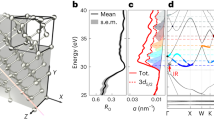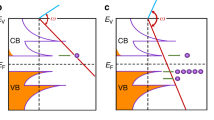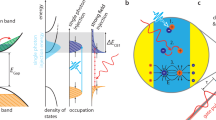Abstract
The photoelectric effect has a sister process relevant in optoelectronics called internal photoemission1,2,3. Here an electron is photoemitted from a metal into a semiconductor4,5. While the photoelectric effect takes place within less than 100 attoseconds (1 as = 10−18 seconds)6,7, the attosecond timescale has so far not been measured for internal photoemission. Based on the new method CHArge transfer time MEasurement via Laser pulse duration-dependent saturation fluEnce determinatiON—CHAMELEON—we show that the atomically thin semimetal graphene coupled to bulk silicon carbide, forming a Schottky junction, allows charge transfer times as fast as (300 ± 200) as. These results are supported by a simple quantum mechanical model simulation. With the obtained cut-off bandwidth of 3.3 PHz (1 PHz = 1015 Hz) for the charge transfer rate, this semimetal/semiconductor interface represents a functional solid-state interface offering the speed and design space required for future light-wave signal processing.
This is a preview of subscription content, access via your institution
Access options
Access Nature and 54 other Nature Portfolio journals
Get Nature+, our best-value online-access subscription
$29.99 / 30 days
cancel any time
Subscribe to this journal
Receive 12 print issues and online access
$209.00 per year
only $17.42 per issue
Buy this article
- Purchase on Springer Link
- Instant access to full article PDF
Prices may be subject to local taxes which are calculated during checkout



Similar content being viewed by others
Code availability
The custom computer code for these simulations is available from the corresponding authors on reasonable request.
References
Krausz, F. & Stockman, M. I. Attosecond metrology: from electron capture to future signal processing. Nat. Photon. 8, 205–213 (2014).
Hong, X. et al. Ultrafast charge transfer in atomically thin MoS2/WS2 heterostructures. Nat. Nanotechnol. 9, 682–686 (2014).
Tan, S. et al. Coherent electron transfer at the Ag/graphite heterojunction interface. Phys. Rev. Lett. 120, 126801 (2018).
Sze, S. M. & Ng, K. K. Physics of Semiconductor Devices (Wiley, 2006).
Di Bartolomeo, A. Graphene Schottky diodes: an experimental review of the rectifying graphene/semiconductor heterojunction. Phys. Rep. 606, 1–58 (2016).
Cavalieri, A. L. et al. Attosecond spectroscopy in condensed matter. Nature 449, 1029–1032 (2007).
Ossiander, M. et al. Absolute timing of the photoelectric effect. Nature 561, 374–377 (2018).
Fassioli, F., Dinshaw, R., Arpin, P. C. & Scholes, G. D. Photosynthetic light harvesting: excitons and coherence. J. R. Soc. Interface 11, 20130901 (2013).
Falke, S. M. et al. Coherent ultrafast charge transfer in an organic photovoltaic blend. Science 344, 1001–1005 (2014).
Wörner, H. J. et al. Charge migration and charge transfer in molecular systems. Struct. Dyn. 4, 061508 (2017).
Scholes, G. D. et al. Using coherence to enhance function in chemical and biophysical systems. Nature 543, 647–656 (2017).
Ma, Q. et al. Tuning ultrafast electron thermalization pathways in a van der Waals heterostructure. Nat. Phys. 12, 455–460 (2016).
Zheng, Q. et al. Phonon-assisted ultrafast charge transfer at van der Waals heterostructure interface. Nano Lett. 17, 6435–6442 (2017).
Eckle, P. et al. Attosecond ionization and tunneling delay time measurements in helium. Science 322, 1525–1529 (2008).
Föhlisch, A. et al. Direct observation of electron dynamics in the attosecond domain. Nature 436, 373–376 (2005).
Menzel, D. Ultrafast charge transfer at surfaces accessed by core electron spectroscopies. Chem. Soc. Rev. 37, 2212–2223 (2008).
Borges, B. G. A. L., Roman, L. S. & Rocco, M. L. M. Femtosecond and attosecond electron transfer dynamics of semiconductors probed by the core-hole clock spectroscopy. Top. Catal. 62, 1004–1010 (2019).
Brühwiler, P. A., Karis, O. & Martensson, N. Charge-transfer dynamics studied using resonant core spectroscopies. Rev. Mod. Phys. 74, 703–740 (2002).
Hong, X. et al. Ultrafast charge transfer in atomically thin MoS2/WS2 heterostructures. Nat. Nanotechnol. 9, 682–686 (2014).
Höfer, U. & Echenique, P. M. Resolubility of image-potential resonances. Surf. Sci. 643, 203–209 (2016).
Marini, A., Cox, J. D. & García De Abajo, F. J. Theory of graphene saturable absorption. Phys. Rev. B 95, 125408 (2017).
Winzer, T. et al. Absorption saturation in optically excited graphene. Appl. Phys. Lett. 101, 221115 (2012).
Xing, G., Guo, H., Zhang, X., Sum, T. C. & Huan, C. H. A. The physics of ultrafast saturable absorption in graphene. Opt. Express 18, 4564–4573 (2010).
Tielrooij, K. J. et al. Generation of photovoltage in graphene on a femtosecond timescale through efficient carrier heating. Nat. Nanotechnol. 10, 437–443 (2015).
Gierz, I. et al. Snapshots of non-equilibrium Dirac carrier distributions in graphene. Nat. Mater. 12, 1119–1124 (2013).
Johannsen, J. C. et al. Direct view of hot carrier dynamics in graphene. Phys. Rev. Lett. 111, 027403 (2013).
Lui, C. H., Mak, K. F., Shan, J. & Heinz, T. F. Ultrafast photoluminescence from graphene. Phys. Rev. Lett. 105, 127404 (2010).
Liang, S. J. & Ang, L. K. Electron thermionic emission from graphene and a thermionic energy converter. Phys. Rev. Appl. 3, 014002 (2015).
Massicotte, M. et al. Photo-thermionic effect in vertical graphene heterostructures. Nat. Commun. 7, 12174 (2016).
Higuchi, T., Heide, C., Ullmann, K., Weber, H. B. & Hommelhoff, P. Light-field-driven currents in graphene. Nature 550, 224–228 (2017).
You, Y. S., Reis, D. A. & Ghimire, S. Anisotropic high-harmonic generation in bulk crystals. Nat. Phys. 13, 345–349 (2017).
Langer, F. et al. Lightwave valleytronics in a monolayer of tungsten diselenide. Nature 557, 76–80 (2018).
Garzón-Ramírez, A. J. & Franco, I. Stark control of electrons across interfaces. Phys. Rev. B 98, 121305(R) (2018).
Acknowledgements
This work has been supported in part by the European Research Council (Consolidator Grant “NearFieldAtto”), Deutsche Forschungsgemeinschaft (Sonderforschungsbereich 953 “Synthetic Carbon Allotropes”, project 182849149 and project WE 3542/7-1) and the PETACom project financed by the Future and Emerging Technologies Open H2020 programme. C.H. is part of the Max Planck School of Photonics supported by BMBF, Max Planck Society and Fraunhofer Society. P.H. greatfully acknowledges a fellowship from the Max Planck Institute of the Science of Light (MPL).
Author information
Authors and Affiliations
Contributions
C.H., T.H., M.H., H.B.W. and P.H. conceived the study. C.H. and M.H. conducted the photocurrent measurements. C.H. analysed the data and provided the plots. M.H. fabricated the samples. C.H. performed the numerical simulations. All authors discussed the obtained results and contributed to the writing of the manuscript. H.B.W. and P.H. co-supervised the experiments.
Corresponding authors
Ethics declarations
Competing interests
The authors declare no competing interests.
Additional information
Publisher’s note Springer Nature remains neutral with regard to jurisdictional claims in published maps and institutional affiliations.
Extended data
Extended Data Fig. 1 Bias-controlled electric field at the Schottky junction.
a, Applying no or a slightly positive bias voltage VB reduces the DC electric field at the Schottky junction, hampering a fast charge transfer. b, A large reverse bias voltage leads to a greater band bending in SiC and hence a larger DC electric field at the interface, increasing the charge transfer rate dramatically (Fig. 3).
Extended Data Fig. 2 Photocurrent for various experimental conditions.
a,b, Photocurrent (a) and efficiency (b) versus laser pulse fluence F as a function of τp and VB. Coloured circles show the data points, while the solid lines are fits including the contributions from PIPE, PTI and 2P-PIPE as explained in Fig. 2b,c. The resulting saturation fluences Fs are indicated by black solid dots. Different colours represent different bias voltages from +0.1 to –6 V (grey to red, see legend). Increasing the negative bias voltage enhances the PIPE extraction rate. As a consequence, Fs is shifted to higher values. Since the saturation is shifted, the superlinear PTI contribution becomes more visible (larger bump). Increasing τp reduces PTI since a high electron temperature can only be reached with short laser pulses, and the saturation is shifted to higher values as well.
Supplementary information
Supplementary Information
Supplementary Information and Figs. 1–7.
Source data
Source Data Fig. 2
Numerical data: measured current versus laser fluence for 0 V and –6 V.
Source Data Fig. 3
Numerical data: saturation fluence versus GDD for –6, –4, –0.3, –0.1 and 0 V.
Rights and permissions
About this article
Cite this article
Heide, C., Hauck, M., Higuchi, T. et al. Attosecond-fast internal photoemission. Nat. Photonics 14, 219–222 (2020). https://doi.org/10.1038/s41566-019-0580-6
Received:
Accepted:
Published:
Issue Date:
DOI: https://doi.org/10.1038/s41566-019-0580-6
This article is cited by
-
Lightwave electronics in condensed matter
Nature Reviews Materials (2023)
-
Light-field control of real and virtual charge carriers
Nature (2022)
-
Attosecond clocking of correlations between Bloch electrons
Nature (2022)



